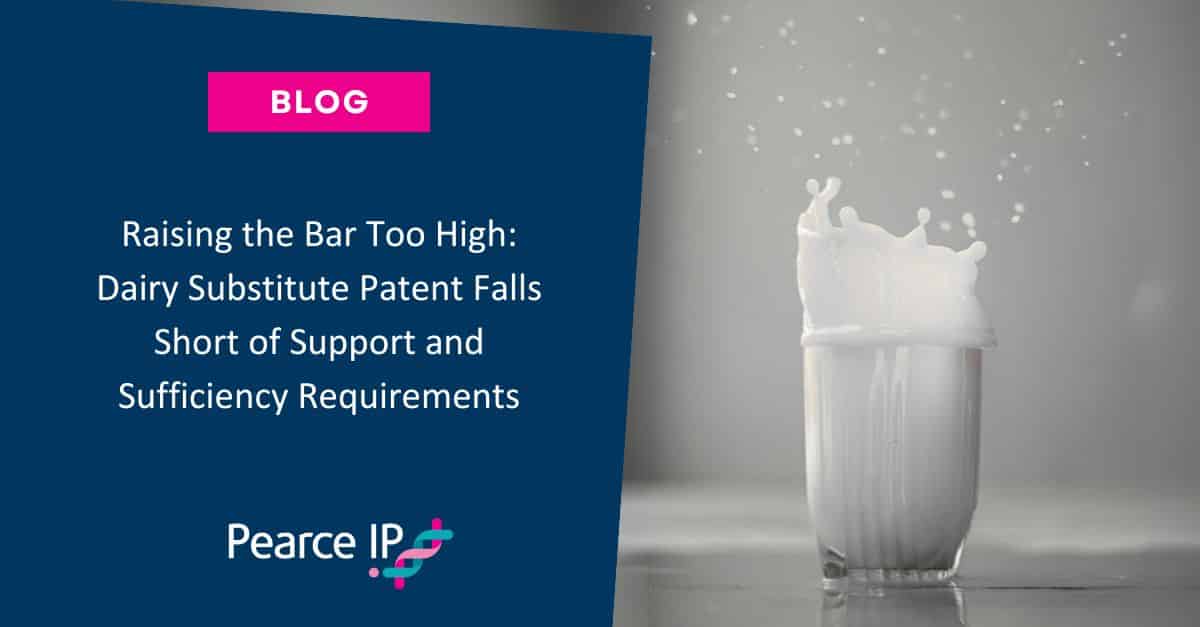| Date of decision: | 28 March 2025 |
| Body: | Federal Court |
| Adjudicator: | Justice Rofe |
Introduction
Earlier this year, the Federal Court of Australia handed down judgment in proceedings between Perfect Day, Inc. and the Commissioner of Patents, in an appeal from an opposition decision concerning a patent application for dairy substitute food compositions. Justice Rofe dismissed Perfect Day’s appeal and refused to allow the application to proceed to grant, finding that the claims failed to meet the heightened support and sufficiency requirements introduced under the ‘Raising the Bar’ amendments.
Background
Perfect Day was the applicant for patent AU2015305271 (the Application), entitled ‘Compositions comprising a casein and methods of producing the same’. The Application was directed to dairy substitutes that aim to replicate the characteristics of mammalian milk, based on the discovery that only a subset of components in the milk can be used to generate a composition that has similar characteristics, such as flavour, appearance, nutritional value, aroma, and mouthfeel. The Application described various milk proteins, though most relevant to the Application were the casein proteins, α-lactalbumin (ALA) and β-lactoglobulin (BLG) proteins and their recombinant equivalents, rALA and rBLG, respectively.
The Application claimed an earliest priority date of 21 August 2014, and was assessed under the Patents Act 1990 following the ‘Raising the Bar’ amendments which introduced heightened requirements for support and sufficiency. Fonterra Co-operative Group Ltd successfully opposed the Application before a delegate of the Commissioner of Patents in Fonterra Co-operative Group Ltd v Perfect Day, Inc. [2022] APO 59, delivered on 23 August 2022. The Delegate found that the specification was directed to dairy substitute foods comprising casein proteins, not compositions with only rALA and rBLG as claimed, and so concluded that all claims lacked support and that the specification failed to disclose the invention clearly and completely enough for performance by a person skilled in the art.
Perfect Day appealed to the Federal Court in September 2022, and also filed two interlocutory applications to amend the Application, seeking to narrow claim 1 to a food composition suitable as a dairy substitute comprising rALA and rBLG and not casein. Fonterra later withdrew as the respondent, with the Commissioner of Patents becoming a party to the proceeding pursuant to r 34.23(2) of the Federal Court Rules.
Key Issues
The appeal centred on two key requirements under the Patents Act 1990:
- Section 40(3): Whether the claims were supported by the specification; and
- Section 40(2)(a): Whether the specification disclosed the invention clearly enough and completely enough for performance by a person skilled in the art.
The Commissioner challenged claim 1 on both grounds. Claim 1 read as follows:
A food composition, other than a cottage cheese or a hard cheese, that is suitable as a dairy substitute, said food composition comprising:
(i) a recombinant β-lactoglobulin protein and a recombinant α-lactalbumin protein, wherein one or both of the recombinant β-lactoglobulin protein and the recombinant α-lactalbumin protein comprises a sequence that is at least 90% identical to the bovine protein amino acid sequence and has been produced by a fungal cell;
(ii) one or more sweetening agents;
(iii) ash; and
(iv) optionally, one or more lipids,
wherein:
the food composition has one or more characteristics of a dairy food product selected from the group consisting of: taste, aroma, appearance, handling, mouthfeel, density, structure, texture, elasticity, springiness, coagulation, binding, leavening, aeration, foaming, creaminess, and emulsification; and the food composition does not comprise any other milk proteins than those in (i).
(Emphasis added – underlining/strikethrough denotes the proposed amendments)
On support, Justice Rofe had to determine whether the Application’s technical contribution to the art justified the broad scope of claim 1, which encompassed compositions with any combination of the 17 listed characteristics in claim 1 (such as taste, aroma, appearance…etc) (the Listed Characteristics), and whether the specification described the claimed invention being compositions containing only rALA and rBLG proteins without casein.
On sufficiency, Justice Rofe had to consider whether the specification provided adequate guidance for the skilled person to make the claimed compositions across their full scope in view of various alleged gaps in the Application’s teaching regarding fundamental aspects of formulating dairy products.
Consideration
Construction
An important threshold issue was the construction of claim 1, particularly the phrase “one or more” in relation to the Listed Characteristics. Perfect Day contended that claim 1 covered compositions with only one characteristic, but not all or even a minimum number of Listed Characteristics, and substantiated this view by reference to infringement, arguing that the claim would be infringed if a product had one of the Listed Characteristics, even if it had more than one. However, Justice Rofe accepted the Commissioner’s broader construction, finding that Claim 1 encompassed compositions with one, multiple, or all of the Listed Characteristics.
Support
The Commissioner argued that the specification was directed to casein-containing compositions that may further include other milk proteins, and methods of making the same, whereas claim 1 was directed to compositions with rALA and rBLG as the only milk proteins and which did not include casein, making them fundamentally different inventions.
Perfect Day responded that the invention, as narrowly claimed, was disclosed in the specification, relying on the following:
(a) The addition of a consistory clause – “…other than a cottage cheese or hard cheese, that is suitable as a dairy substitute, said food composition…”; and
(b) Selected references in the specification as being a disclosure of the ALA and BLG proteins being in a food composition independently of casein, such as: “also provided are kits that include: (a) a mixture of one or more milk proteins, one or more fats, and one or more flavour compounds; and (b) a mixture of ash and at least one sweetening agent”. Further, the Application stated that in some embodiments of the kits, “the one or more milk proteins are selected from the group of: β-casein, κ-casein, [ALA], [BLG] … and serum albumin”
Justice Rofe found that the invention claimed was fundamentally different from the invention disclosed in the specification when read as a whole. The specification described food compositions that included casein and may further include other milk proteins, whereas the claimed invention comprised rALA and rBLG as the only milk proteins and did not include casein (or any other milk proteins). Critical to her Honour’s analysis was that, save for the consistory clause, and as accepted by Perfect Day’s expert witness, Professor Tong, there was no mention of a food composition suitable as a dairy substitute comprising BLG and ALA and no other milk proteins, nor any description of making such a composition. Moreover, the specification positively stated that, if sufficient casein was not present, micelles would not form, leading to poor mouth feel in synthetic milk products as micelles were particularly important for the optimum behaviour of milk.
Her Honour also rejected Perfect Day’s reliance on selected phrases from the specification, finding that even the strongest reference – which described BLG and ALA as the primary component of “at least a part of the milk protein component or composition” – did not convey an “inferential disclosure of a composition comprising ALA and BLG and no other milk proteins”. In the context of an extensive specification describing casein-containing compositions, her Honour stated that an absence of casein “would require express wording to that effect”.
The Commissioner also contended that that the technical contribution of the invention described in the specification did not support food compositions having more than one, or all of the Listed Characteristics.
In response, Perfect Day argued that the essence of the invention was not referrable to the combination of the Listed Characteristics, but was with respect to the development of a dairy substitute that used recombinant proteins without casein. In view of this, Perfect Day contended that enabling one characteristic at a time was sufficient given the claim’s “one or more” language, and the resulting composition did not have to be a ‘good’ dairy substitute as long as the ‘important characteristic’ was replicated.
Justice Rofe agreed with the Commissioner’s position, finding that claim 1 encompassed “compositions which might have one of the Listed Characteristics, as well as compositions which have two or even all of the Listed Characteristics”. Her Honour noted that Professor Tong’s evidence that recreating all the characteristics would be “tremendous” demonstrated that the scope of claim 1 exceeded the technical contribution provided by the specification as whole. Although Professor Tong could make compositions with one characteristic “reminiscent” of dairy products, Justice Rofe found he was applying his own expertise rather than following the Application’s teachings, which failed to explain fundamental aspects such as whether post-translational modification caused rALA or rBLG to form micelles (critical for milk behaviour) or how to achieve coagulation with rennet in the absence of casein (necessary for cheese). His evidence also revealed that different characteristics applied to different dairy products, further demonstrating that the broad scope of claim 1 could not be justified by the Application’s limited disclosure. For these reasons, Justice Rofe concluded that the Application lacked support.
Sufficiency
The Commissioner’s arguments on sufficiency mirrored those made in respect of support, namely, that the invention claimed was different from that disclosed in the specification, and that the specification provided no meaningful assistance for producing the claimed products with combinations of Listed Characteristics, offering at best a ‘starting point’ that left the skilled person to rely on their common general knowledge alone.
Consistently with its position on support, Perfect Day argued that claim 1 only required that the claimed composition be “suitable as a dairy substitute” by possessing one Listed Characteristic, arguing that the sufficiency requirement should therefore not require more than enabling one characteristic at a time. Perfect Day again relied on the consistory clause as sufficient disclosure and Professor Tong’s evidence that compositions with individual characteristics could be produced without undue burden.
In addition to the matters which her Honour had considered in the context of support, Justice Rofe noted that Professor Tong acknowledged that the Application did not disclose a formulation he could follow from start to finish and that his ‘starting point’ simply involved replacing casein with rALA and rBLG without being able to predict the resulting properties of the product. Cross-examination of Professor Tong also revealed that many experiments, anywhere from “more than 10” and possibly within the realm of 100, might be required to produce a particular dairy substitute composition with the desired characteristic(s).
Critically, Justice Rofe found that the Application provided no guidance for making dairy substitute compositions with two or more of the Listed Characteristics, concluding that such work would require “an exercise of inventive skill or ingenuity or undue effort” rather than routine work by a skilled person. Accordingly, her Honour found that claim 1 lacked sufficiency.
Outcome and Implications
Justice Rofe dismissed Perfect Day’s appeal, finding that claim 1 of the amended Application lacked both support and sufficiency and should not proceed to grant.
The decision provides important guidance on the heightened support and sufficiency requirements under the “Raising the Bar” amendments to the Patents Act. Justice Rofe’s decision also illustrates the risks of claiming broad ranges of characteristics in complex technical fields, and reinforces that consistory clauses and vague references cannot cure fundamental disconnects between specifications and claims.
About Pearce IP
Pearce IP is a specialist firm offering intellectual property specialist lawyers and attorneys with a focus on the life sciences industries. Pearce IP and its leaders are ranked in every notable legal directory for legal, patent and trade mark excellence, including: Chambers & Partners, Legal 500, IAM Patent 1000, IAM Strategy 300, MIP IP Stars, Doyles Guide, WTR 1000, Best Lawyers, WIPR Leaders, 5 Star IP Lawyers, among others.
In 2025, Pearce IP was recognised by Australasian Lawyer and New Zealand Lawyer’s 5 Star Employer of Choice, and is the “Standout Winner” for inclusion and culture for firms with less than 100 employees. Pearce IP was awarded “IP Team of the Year” by Lawyers Weekly at the 2021 Australian Law Awards. Pearce IP is recognised by Managing IP as the only leading ANZ IP firm with a female founder, and is certified by WEConnect International as women owned.

Naomi Pearce
CEO, Executive Lawyer (AU, NZ), Patent Attorney (AU, NZ) & Trade Mark Attorney (AU)
Naomi is the founder of Pearce IP, and is one of Australia’s leading IP practitioners. Naomi is a market leading, strategic, commercially astute, patent lawyer, patent attorney and trade mark attorney, with over 25 years’ experience, and a background in molecular biology/biochemistry. Ranked in virtually every notable legal directory, highly regarded by peers and clients, with a background in molecular biology, Naomi is renown for her successful and elegant IP/legal strategies.
Among other awards, Naomi is ranked in Chambers, IAM Patent 1000, IAM Strategy 300, is a MIP “Patent Star”, and is recognised as a WIPR Leader for patents and trade marks. Naomi is the 2023 Lawyers Weekly “IP Partner of the Year”, the 2022 Lexology client choice award recipient for Life Sciences, the 2022 Asia Pacific Women in Business Law “Patent Lawyer of the Year” and the 2021 Lawyers Weekly Women in Law SME “Partner of the Year”. Naomi is the founder of Pearce IP, which commenced in 2017 and won 2021 “IP Team of the Year” at the Australian Law Awards.

Helen Macpherson
Executive, Lawyer (Head of Litigation –Australia)
Helen is a highly regarded intellectual property specialist and industry leader with more than 25 years’ experience advising on patents, plant breeder’s rights, trade marks, copyright and confidential information. She is known for her expertise in complex, high-value patent matters and leverages her technical background in biochemistry and molecular biology to work across a wide range of technologies, including inorganic, organic, physical and process chemistry, biochemistry, biotechnology (including genetics, molecular biology and virology), and physics. Helen is an active member of the Intellectual Property Committee of the Law Council of Australia and the Intellectual Property Society of Australia and New Zealand.

Nathan Kan
Lawyer
Nathan is a lawyer specialising in life sciences, providing legal advice and litigation support across intellectual property and commercial disputes. He is passionate about the intersection of law and science, and during his time with the Science and Technology Law Association at the University of Melbourne, he helped lead events, workshops and publications across STEM fields including life sciences, AI and digital transformation.

